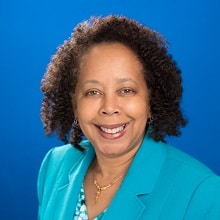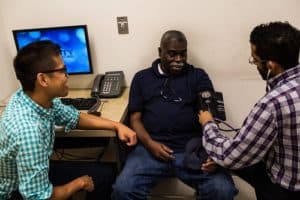Inside Angle
From 3M Health Information Systems
Bridging the health care inequality divide: Pandemic solutions
Today’s blog is co-authored by Angela Diop, ND, CHCIO, and Andrew Robie, MD, of Unity Health Care in Washington DC. Dr. Robie is Chief Medical Information Officer and a family physician at Unity. Dr Diop is Unity’s Chief Information Officer.
Many Americans report barriers in obtaining timely access to primary care services.1 These access challenges have been multiplied in unique ways during the COVID-19 pandemic. In the initial phase of the U.S. pandemic response, the lack of PCR testing and personal protective equipment (PPE) made it difficult to readily determine COVID-19 positive cases and initiate proper contact tracing.2 The resulting social distancing and shelter in place measures instituted in most of the country continue to make in-person primary care difficult to accomplish.

Unity Health Care is a case study in how the pandemic has affected primary care for underserved communities, highlighting a need for new access solutions. A District of Columbia Federally Qualified Health Center (FQHC), Unity has addressed the health needs of vulnerable populations for over 30 years. Like other safety net primary care centers, Unity, a Level 3 Patient-Centered Medical Home (PCMH) Community Health Center, already operates with a lower than needed staff to patient ratio.3 The pandemic further exacerbated staff shortages due to COVID-19 exposure and illness of its staff. As social distancing measures were implemented to mitigate the spread of the virus in March, Unity’s daily visit volume plummeted by 60 percent. Unity’s 23 health care service sites include 9 community health care centers, 12 homeless sites, a mobile unit, 2 school-based health centers, ex-offender re-entry services and comprehensive health care services in the District’s correctional facilities. Unity’s patient population is 89 percent African American and 19.8 percent Hispanic/Latino; 72.6 percent have income at or below 100 percent of the federal poverty level and 10.6 percent are homeless. So, persons with high economic, cultural and/or linguistic barriers to primary medical care services (the populations at highest risk for poor COVID-19 outcomes) were no longer getting necessary medical and behavioral health care at Unity.

The daily challenge for the remaining Unity staff was to continue to offer high quality care for the communities they serve and generate enough patient services revenue to continue operating. This had to be done in a way that would protect patients and staff from unnecessary exposure to infection in the community, on public transportation and in the clinics, as well as minimize use of the personal protective equipment that was in such short supply. Telehealth was the solution.
Telehealth as a game changer
Unity is a two-time winner of the Health Information and Management Systems Society (HIMSS) Davies Award of Excellence for outstanding achievement in using health information technology to substantially improve patient outcomes and value. Unity’s telehealth program prior to the pandemic was entirely grant supported. Fortunately, in mid-March, the Medicaid Authority in DC, in response to the need for enhanced access to care while maintaining social distancing, implemented emergency rules recognizing the patient’s location as a reimbursable telehealth originating site. This effectively made direct-to-patient audio and video telehealth visits financially viable.

Video visits are conducted using a patient-friendly interface and appointment invitations sent via text message, a modality more widely accessible to Unity patients. Unfortunately, 50–80 percent of patients either did not have access to the hardware necessary for a video telehealth visit, lacked a reliable email to activate the visits, or had other reasons for non-participation (lack of comfort using available technology, desire for an in-person visit, etc.). So, while a few successful direct-to-patient video visits were well-received by patients and providers, it was clear that video telehealth alone would not alleviate access barriers.
Audio-only telehealth allows 80 percent more patients to access care. All scheduled patients are called at least 24 hours in advance of their visit to offer a conversion from in-person to telehealth. All new appointment requests are conducted via telehealth. After only three weeks of this telehealth program, Unity has recovered approximately 70 percent of its usual visit volume and approximately 70 percent of these visits are conducted using telehealth. Of the telehealth visits, approximately 20 percent are conducted via video while 80 percent are audio-only. Audio visits also allow successful monitoring of patients who are homeless and isolated or quarantined at hotel sites established by the city. Other visit types being added now include evaluation of acute dental complaints and video group visits for prenatal patients, as well as those with opioid use disorder on buprenorphine.
Opportunities and future possibilities

Because of the COVID-19 public health emergency, telehealth reimbursement changes have dramatically expanded telehealth access and the range of providers (nurse practitioners, clinical psychologists and licensed clinical social workers) who can offer it.4 Given Unity’s experience, telehealth can continue to be leveraged to address even more opportunities to close the health equity divide. Telehealth visits can be used to develop patient-centered customized plans for mitigating COVID-19 exposure for those at highest risk of hospitalization. These plans should account for whether the patient or a household member works outside the home, the understanding of and ability to execute required hygiene practices, social distancing and the proper use of masks. These encounters also present the opportunity to assess changing patient social determinants of health, given the economic downturn and the accompanying rise in unemployment, food and housing insecurity.

In DC, 25 percent of households lack broadband access and another 17 percent lack access to a computer,5 illustrating the digital divide challenges to expanding the use of video telehealth. In order to realize the full capability of video-enabled telehealth to vulnerable populations, internet connectivity, training and internet enabled devices would be needed for those patients who could not afford them. Remote patient monitoring solutions including blood pressure monitors, glucometers, pulsoximeters, scales, and activity trackers could also be very valuable, especially for home monitoring patients with COVID-19 to alleviate burden on emergency departments. For those with chronic conditions at highest risk for preventable emergency department visits and hospital admission, the cost of these devices would be justified from a population health perspective. Medicaid Managed Care Organizations can work with network providers such as Unity to use high needs population identification methodologies such as 3M™ Clinical Risk Groups (CRGs) and track success of telehealth-based interventions using population health event methodologies such as the 3M™ Potentially Preventable Events.
Medically underserved patients, such as Unity’s, are already burdened by challenges with transportation to health care appointments and have the highest need for multiple appointments for ongoing chronic care management, medication refills and mental health counseling. The pandemic has provided a much-needed acceleration of the use of telehealth for these purposes. With proper attention to privacy laws, reimbursement and closing the digital divide, telehealth can continue to increase access to the populations who need it the most.
Melissa E. Clarke, MD, CMQ, is a Clinical Transformation Physician Consultant with 3M Health Information Systems.
Learn more about 3M’s decades-long research into risk classification methodologies by visiting 3M Clinical and Economic Research.
References
1 Tolbert J, Orgera K, Singer N, and Damico A. Key Facts about the Uninsured Population. Kaiser Family Foundation. Dec 13, 2019 accessed at https://www.kff.org/uninsured/issue-brief/key-facts-about-the-uninsured-population/
2 Kates J and Michaud J. Put to the Test: Can the U.S. Get to the Next Phase of the COVID-19 Response? April 1, 2020 accessed at https://www.kff.org/coronavirus-policy-watch/put-to-the-test-can-the-u-s-get-to-the-next-phase-of-the-covid-19-response/
3 Rust G, Melbourne M, Truman BI, Daniels E, Fry-Johnson Y, Curtin T. Role of the primary care safety net in pandemic influenza. Am J Public Health. 2009;99 Suppl 2(Suppl 2):S316–S323. doi:10.2105/AJPH.2009.161125
4 “Coronavirus Aid, Relief, and Economic Security Act” of 2020, HR 748, 116th Congress § 2 (2020)
5 Office of the Chief Technology Officer, Connect DC “Building the Bridge: A Report on the State of the Digital Divide in District of Columbia,” April, 2015.


